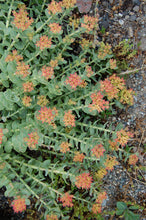Sedum Rhodiola, Golden Root, Rose Root, Russian Rhodiola, Aaron's Rod, Arctic Root, King's Crown and Orpine Rose are all names given to this fleshy succulent perennial, steeped in folklore, and revered by herbalists. Growing from 2 to 16 inches tall (5-40 cm) with yellow flowers, which sometime contain red and purple hues, this hardy plant survives in Arctic areas with ease, and has to be one of the hardiest medicinal plants known.
It will grow in a variety of soil types, from rocky gravel and heavy clay to silty, sandy and peaty loam, preferring sun when grown at altitude or shade to part shade at lower elevations. Hardy in Zones 1 to 7.
Sow seeds in the fall or very early spring, as they need stratification of approximately 2 months at 5°C (40°F) or colder. Sow on the surface of a fast-draining potting soil, tamp down, and expose to outdoor conditions - snow, rain, and temperature fluctuations - all of which stimulate germination. If outdoor conditions are unavailable, the seeds may be stratified for 90 days in a moist medium in the refrigerator, and then surface-sown in cool shade.
Prick out seedlings and work up in successively larger pots until the plants are a good size to transplant out, spacing a foot apart. Or they can remain in pots to maturity with great results.
The young succulent leaves and shoots can be eaten raw or cooked like spinach, and have been used like aloe to treat cuts and burns. The Inuit used a decoction of the flowers for stomach and intestinal discomfort, and also for treating tuberculosis. Viking warriors used roseroot as medicine before going into battle.
There are a number of different ecotypes of Rhodiola rosea all of which contain the immune stimulating glycosides, rosavin, and rosin in their rose-scented roots, but in varying amounts. These glycosides have the ability to restore the body and mind after physical and mental exertion and stress, classing it as a true adaptogen.
The roots are harvested at a minimum of 3 years old, or better still, at 4 or 5 years, where the root mass increase gives rise to higher rosavin and rosin content.
Research has shown that the roots not only act as a general tonic but also improve learning and memory, combat depression and aid weight loss.




